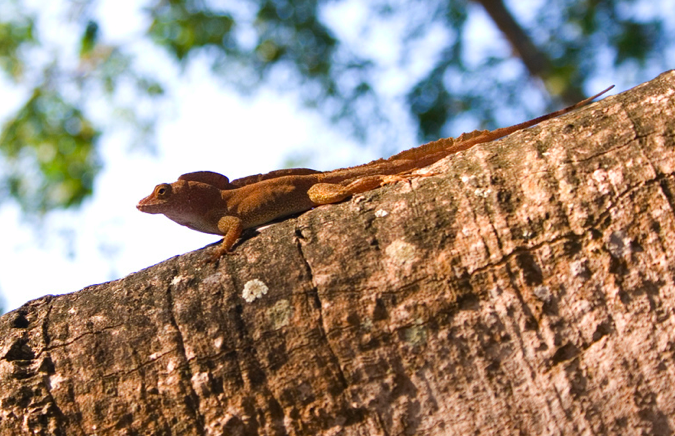

| Visitors Now: | |
| Total Visits: | |
| Total Stories: |
Physiological Adaptation On Ecological Timescales – New Research By Alex Gunderson And Manuel Leal

Anolis cristatellus from Puerto Rico. Photo taken by Liam Revell
Anolis lizards are a model system for studies of evolutionary ecology because they are remarkably adaptable creatures. We know from long-term studies conducted by Jonathan Losos, Dave Spiller, Tom Schoener, and others that anoles can rapidly adapt their behavior and morphology over ecological timescales. For example, the presence of a ground-dwelling predator (Leiocephalus carinatus) forged a strong selective gradient in favor of A. sagrei with longer hindlimbs within a single generation. Interestingly, in a follow-up study the long-term effect of this predator is that A. sagrei evolves shorter hindlimbs, as they will tend to perch higher off the ground, where the perch diameter is narrower than near the ground. These studies of rapid morphological evolution puts anoles in the a very exclusive club with the likes of stickleback fishes, Peromyscus beach mice, guppies from Trinidad, Galapagos finches, and few others, as vertebrate systems in which evolutionary change on ecological timescales has been confidently demonstrated.
A notable exception to Anolis ‘evolvability,’ however, is thermal physiology. The thermal physiology of reptiles is generally evolutionarily conserved – taxa separated by millions of years and found in very different thermal environments will often share similar physiological patterns. But recent research has suggested that some physiological metrics may not be as static as previously thought, and that Anolis invasions provide an excellent opportunity to see how labile physiology actually is.
Although native to the balmy isle of Puerto Rico, A. cristatellus has made a permanent home in Florida. This species is now well established in South Florida, and even on some of the offshore islands. Although Florida may seem perpetually warm to a denizen of the Northeast like me, it is actually much colder than Puerto Rico. In a previous study, Jason Kolbe and colleagues demonstrated that the thermal niches (i.e., available thermal habitat) are quite divergent between Puerto Rico and Florida, and showed a rapid evolutionary response in acclimation to thermal environment in one of the invasive populations. This sets up the possibility that invading anoles will evolve their thermal physiology to match their new environment.

Figure 1. Maximum air temperatures (top lines) and minimum air temperatures (bottom lines) for Miami (solid) and Puerto Rico (dashed) since the A. cristatellus invasion.
Enter Manuel Leal and Alex Gunderson from Duke University. In their most recent paper, they examine whether physiology has evolved in the invasive populations of A. cristatellus from Miami. As Manuel explains on his blog, anoles can use behavior to stay warm during the day, but cannot escape the cold at night. Indeed, the maximum temperatures appear to vary little between Miami and Puerto Rico (Fig. 1). The minimum temperatures, however, show appreciable variation, particularly in winter, where they are separated by about 10°C. He posited that there was possibly a strong selective pressure for adapting to the lower nighttime temperatures through a lower cold tolerance (critical thermal minimum, or CTmin). Alex, however, was more skeptical in light of the overwhelming evidence that physiological evolution is predominantly conserved.

Figure 2. Box plots showing the critical thermal minimum (CTmin) values of A. cristatellus from Miami (gray) and Puerto Rico (white) measured in the spring and fall.
For their cold tolerance experiments, Alex and Manuel examined A. cristatellus from Miami in the spring and in the fall, and from Puerto Rico in the fall (Fig. 2). Despite tangibly different ambient air temperatures in spring and fall, CTmin was not significantly different among Miami lizards. However, mean CTmin was lower by about 3°C in the Florida populations than in the Puerto Rican population. This difference in CTmin between invasive and native populations is quite dramatic in light of the fact that thermal physiology is highly conserved among reptiles and this difference evolved over the course of about 35 generations. Certainly this is compelling evidence for physiological adaptation in anoles over ecological timescales.
Something that struck me while reading this paper is that, although thermal physiology is predominantly conserved among lizards, anoles are a notable exception to this rule. Rodolfo Ruibal, Stan Rand, Paul Hertz, and Frederica van Berkum, among others, have documented extensive variation in thermal physiology among anoles. It is also true that physiological lability is most obvious among closed canopy anoles, and A. cristatellus is an open-habitat species – perhaps its physiology is consequently not expected to be as labile. However, that such strong physiological adaptation can occur over such a short timescale is quite remarkable, even if anoles generally show evolutionary lability in physiological traits.
An important implication for this research is that it may alter our perception of how reptiles will respond to climate warming. Many forecasts predict that tropical reptiles, particularly those in closed canopy forests, will be especially susceptible to climate warming because of their physiological preference for cooler temperatures and the entrenched idea that thermal physiology is evolutionarily inert. Leal and Gunderson demonstrate that dramatic physiological evolution can occur over short timescales, and can potentially aid organisms, at least in the short run, to buffer the effects of environmental warming. The eventual effect of warming, however, is that neither physiology nor behavior will be able to fully mitigate the hotter thermal environment, and that an alarming number of reptiles are at risk of extinction.
![]() Manuel Leal & Alex R. Gunderson. (2012). Rapid change in the thermal tolerance of a tropical lizard. The American Naturalist. 180: 815-822. DOI: 10.1086/668077
Manuel Leal & Alex R. Gunderson. (2012). Rapid change in the thermal tolerance of a tropical lizard. The American Naturalist. 180: 815-822. DOI: 10.1086/668077
//
2012-11-16 10:41:10
Source:



